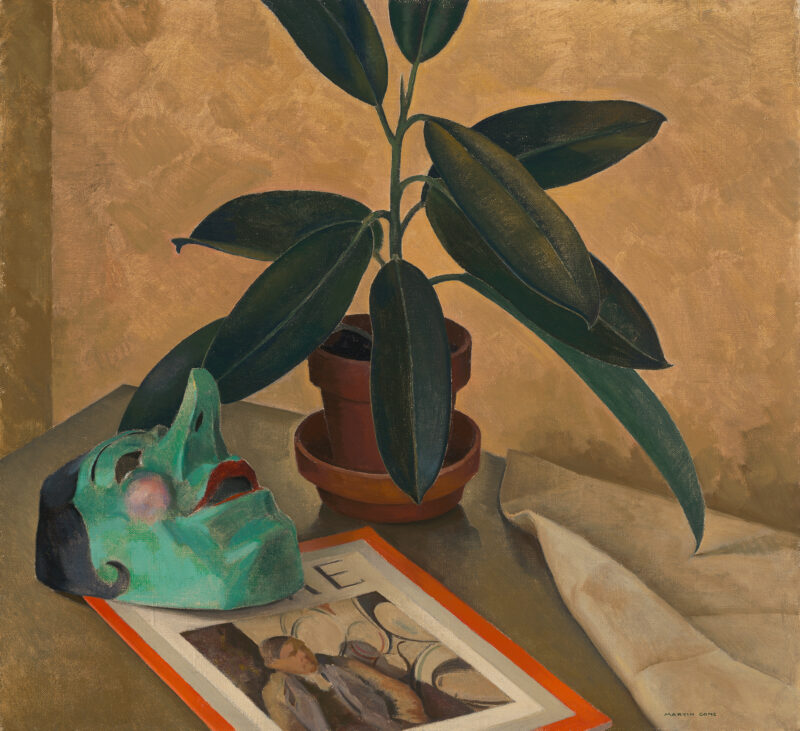
Still Life with Mask
Cone, Marvin D.
1939
Artwork Information
-
Title:
Still Life with Mask
-
Artist:
Cone, Marvin D.
-
Artist Bio:
American, 1891–1965
-
Date:
1939
-
Medium:
Oil on canvas
-
Dimensions:
22 1/8 x 24 1/8 inches
-
Credit Line:
Wichita Art Museum, Museum purchase, Burneta Adair Endowment Fund
-
Object Number:
1992.6
-
Display:
Not Currently on Display
About the Artwork
Marvin Cone is most often recognized in art texts for his association with the Regionalist painter Grant Wood. Both men were natives of Cedar Rapids, Iowa, where they went to school together. As young artists wishing to expand their grasp of methodology and history they traveled to Paris together to acquaint themselves with the work of the masters, old and modern. Once back in Iowa, Wood and Cone remained friends and collaborated on the establishment of the famous Stone City Art Colony. Even though Cone’s work is much less known than that of Wood who painted American Gothic, along with numerous other icons, Cone delivers the “goods” as well as anybody—craft, beauty, wit.
The Picasso Number is a gorgeous painting, all the more delightful for its seemingly modest demeanor as a still life. The subject derives from a series of similar still-life and interior views that Cone did of his home/studio. The objects are attractive because of their individuality and their personal significance to the artist.
The mask, like all good masks, evokes intrigue through its grotesquery and its candid declaration of deception or illusion. It is a theater mask in the tradition of the 17th century Italian commedia dell’arte so it connotes cosmopolitan cultural taste on the part of its owner. However the long pointed nose and the almost noxious blue-green base color with glowing red cheeks and lips, shiny slick black hair and eyes gives one a slight case of the creeps—like hilarity gone amuck. The magazine delights because it is a familiar one even today, Time, a publication indicative of attention to current events, social trends, and in-the-knowingness. This particular cover, dating February 13, 1939, heralds the fixedness of Modern Art—embodied in the person of Picasso—in the American popular consciousness. Obviously, Cone, who had been ahead of the crowd for some time now as far as art is concerned, took pleasure in seeing his profession, and a radical example at that, celebrated on the cover of Time—almost as good as having the Queen of England knight the Beatles. And finally, there is the ubiquitous tall, shiny-dark-green-leaved houseplant in its classic clay pot, an elegantly ornamental plant used to adorn the lobbies of suave bank and hotel interiors, as well as the interior Cone’s Arts and Crafts style home.
Oh, finally, we come to the aesthetic glory of the piece. The sheer classic competence of the color, design, and paint handling takes one’s breath away: the design incorporates the calculated casualness of the Japanese Edo woodcut—asymmetrical massing of objects on one side of the picture plane, a close-up view that crops all the objects including the table that is seen only as a triangular edge piercing the picture plane, and the enticing glimpse of a distant room in the slender strip of an opening at far left edge of the picture.
The color schema is a rich harmony of gold and olive hues suggestive of both organic life and precious metals, given an edgy, jazzy accent by the insertion of the neon aqua green of the mask and the red spirals of the magazine cover. The paint texture of the background is the coup de grвce, an even pattern of individually visible rectilinear brush strokes that reflect the light and give the impression of hammered gold.